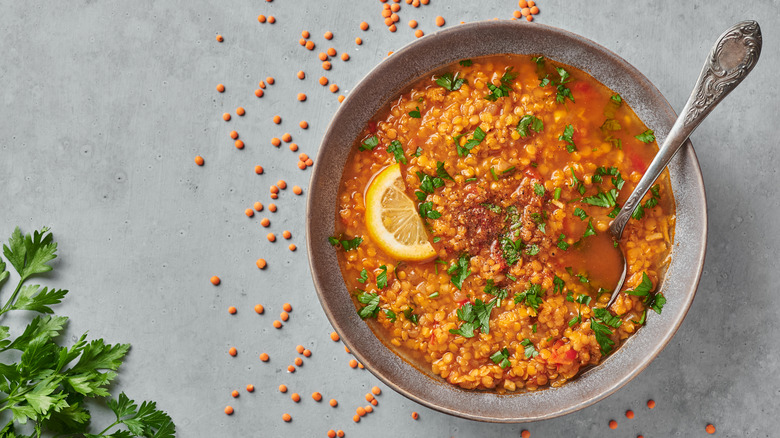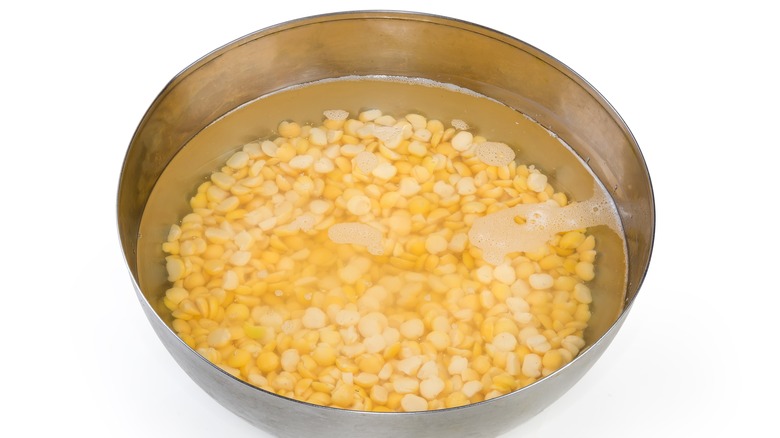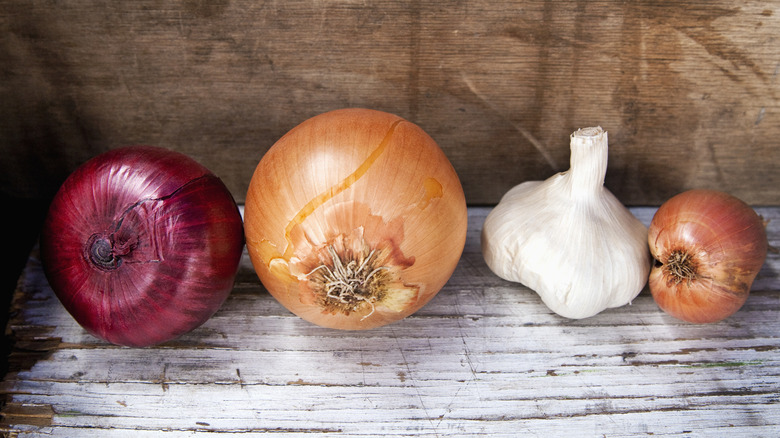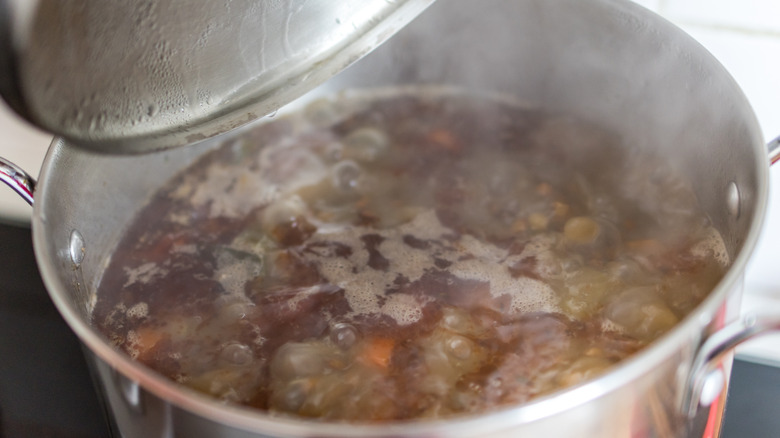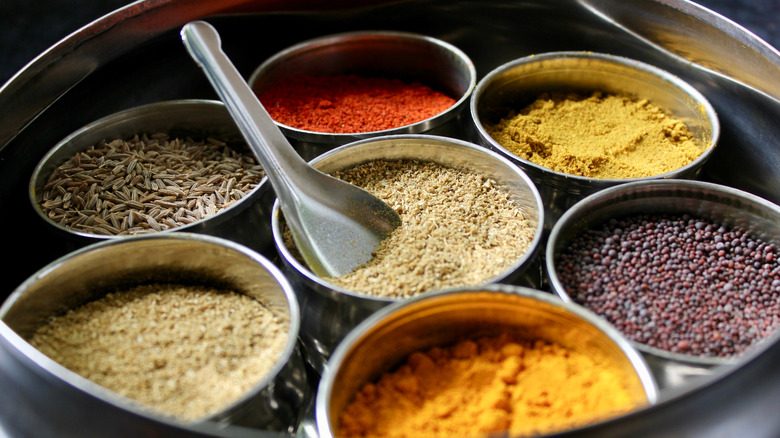The Right Way To Make Daal In An Instant Pot According To A Pro
We may receive a commission on purchases made from links.
Daal, also spelled with just one "a," means to split in Sanskrit, a translation that doesn't fully explain the ins and outs of this popular Indian food staple, or why it's such a great candidate for your next Instant Pot meal. The split here refers to halved or whole lentils, peas, beans, or pulses that usually make up daal dishes, though saying that a bowl of daal is just a steaming bowl of split red lentils (or what have you) doesn't quite get to the heart of it.
And while daal's definition might be a tad complex for the uninitiated, Chowhound has been assured by Varun Inamdar, chef and owner of 27 Degrees West in Singapore, Anokhi Bar & Grill in Shanghai, and New Light Sopore in Kashmir, emphasizes that "making dal in an Instant Pot is quick and easy!" His culinary expertise is also showcased on the Rajshri Food YouTube channel, which features video walkthroughs of 100% vegetarian recipes — including some for daal.
If you've made daal on the stovetop before, then you'll be happy to learn that some of the steps you take to make this classic Indian comfort food in an Instant Pot remain the same. This definitely lessens the learning curve. Fortunately, this popular kitchen tool also cuts out some of the steps or, at least, cuts down on the time and energy required to complete them. In other words, you get the best of both worlds when you make daal in an Instant Pot, such as the brand's classic 7-in-1 model. Here's what you need to know to get started.
Soak the daal to make cooking easier
Technically, since an Instant Pot is so powerful, you don't need to soak your dry lentils before cooking them. Although, according to chef Varun Inamdar, you'll save some time if you do soak them. "If you're using split lentils like toor or moong dal, soaking them for 30 minutes can reduce cooking time," he says.
Aside from this, lentils contain compounds known as phytates and lectins. For some people, these compounds cause digestive issues, which can be abated if the pulses are soaked before cooking. If you do decide that soaking your lentils is in order, put them into a pot with a lid and soak them to your satisfaction. Provided that your kitchen doesn't run on the warm side, allowing them to sit in water for up to 12 hours won't harm them. However, don't let them soak for longer or they might start sprouting. In light of that, you may want to err on the side of caution and stick with the 30-minute time frame that Inamdar recommends.
Sauté the aromatics for a deeper flavor
Chef Varun Inamdar suggests that home cooks use their Instant Pot's sautéing function to enhance the flavor of their daal recipe. As far as what to sauté, you can start with some aromatics that many chefs use to liven up the flavors of their Indian dishes. Onions, leeks, and spring onions –- sometimes also called scallions or green onions — count among the common aromatics included in Indian cuisine, as do garlic cloves, carrots, and tomatoes. Inamdar recommends sautéing these along with some spices in oil or ghee.
Fresh ginger is another flavor commonly found in Indian cooking. Some chefs prefer to cook ginger with the skin on, because it gives the dish more flavor. If you like more than a hint of ginger in your daal, take this route and slice the unpeeled ginger into small pieces. However, if you're sensitive to the flavor, you can peel the ginger with the round end of a spoon before chopping it up to sauté.
Daal is considered comfort food — like a good bowl of creamy Ramen noodles or some hearty mashed potatoes — and aromatics infuse foods with some of their most comforting features, as well as a bit of savory flavor or a spicy nip. The message here? Don't skimp on this step when you're making daal.
The water-to-lentils ratio is flexible
As far as making daal is concerned, adding water is often a play-it-by-ear kind of thing. For free-wheeling home cooks, this sort of freedom equals a barrel of fun. For the inexperienced daal chef, not so much, particularly when you add an extra complication, like cooking it in an Instant Pot. Dry daal, anyone?
If you count yourself among the free-wheelers, try this tip: Keep the water level in your lentils at about 1 inch above the lentil line. This gives you a bit of leeway without you having to worry about measuring the water exactly. If you fall into the by-the-book camp, Varun Inamdar suggests using 3 cups of water for each cup of lentils in the daal recipe. You can adjust this as desired. For example, if you like your daal thick and stew-like in consistency, rather than soup-like, go with less than 3 cups of water.
Work with seasonings to heighten the flavors
Spices play a big role in cooking daal. Varun Inamdar cites cumin, mustard seeds, and turmeric as some of his go-to spices for seasoning lentils. In India, these spices can usually be found in a type of round tin called a masala or spice dabba; this container from Tanish Trading includes seven compartments for storing your essential seasonings. Other spices in the dabba might include garam masala, cassia bark, chili powder, coriander powder, cardamon, and cloves.
Because daal refers to both the split pulses and the different types of dishes you can make from them, you may find recipes that call for more spices than Inamdar has recommended. Therefore, any additional spices in your dabba tins may come in handy when cooking Indian food in the future, even if you don't use them in your daal recipe today.
As for seasoning the daal after it's finished, Inamdar has one more suggestion. "Add salt after cooking," he says, noting, "If added before, it can make the lentils tough." When it's time to serve the dish, he recommends a few garnishes for flavor: "fresh cilantro, lemon juice, or a dollop of cream or ghee for added richness."
Daal the next day
Anyone who has cooked in an Instant Pot knows that the appliance is generous in size, to put it mildly. As such, it's a great tool for making larger batches of daal to refrigerate or freeze for later. Of course, there's no need for a good pot of extra food to go to waste. If you've made too much daal, put it in an airtight container and stash it in the fridge. It'll keep for up to five days. And not to worry about the flavor. "[It] often tastes even better the next day as the flavors meld," says Varun Inamdar.
If you're not planning on eating your leftover daal immediately, freeze it instead. It's best to wait until the daal has cooled completely before you stick it in the freezer. Once it has cooled off, store it in plastic zipper bags or sealed containers. Most daal recipes stay edible in the freezer for three to four months.
